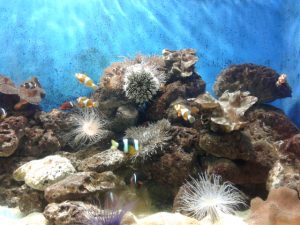The Best Approach to an Economic Marine Instability: Guam’s Coral Reefs
By Casey Dresbach, SRC Intern
Integrated models can simulate the ecological, social, and economic consequences of different marine management approaches. In this study, a dynamic reef biophysical model is linked with human behavior models for the coral reef ecosystem of Guam (jcpag2012, 2012). Researchers, Mariska Weijerman, Cynthia Grace-McCaskey, Shanna L. Grafeld, Dawn M. Kotowicz Kirsten L.L. Oleson, Ingrid E. van Putten completed a study that addressed this problem in detail.
For Guam, fishing and diving are two important reef-based activities directly reliant on Guam’s coral reef ecosystems. Guam residents as well as tourists participate in between 256,000 and 340,000 dives on Guam’s reefs every year. Tourism is one of the country’s largest economic sectors, due in part to Guam’s status as a world-class scuba diving destination. Much of the fishing pressure exerted on Gaum’s coral reefs comes in the form of artisanal or subsistence fishing. Consequently, most of the catch goes unreported as it is destined for personal consumption rather than the open market.
Since there is an advanced tourism industry in Gum there are corresponding challenges to environmental sustainability. The problems that evolve as a result of such activities result in a heavy decline or loss of important fish species as well as the degradation or acidification of reefs from an inadequate treatment of sewage systems. Guam’s reefs have also been troubled by poorly executed coastal development and high sediment load from land burning in watersheds, an area or region drained by a river, river system, or other body of water.
This combination of factors caused policy makers to seek alternative approaches. In this case study, Mariska Weijerman, Cynthia Grace-McCaskey, Shanna L. Grafeld, Dawn M. Kotowicz Kirsten L.L. Oleson, Ingrid E. van Putten sought to create an integrated model to analyze a hypothetical way of a better management system. Three agencies in Guam worked to implement fishing limitations and reduce land-based sources of pollution in order to improve the quality of its watersheds. The study was done to model the current situation in Guam by combining all factors (e.g. social, economic, biologic) and analyzing the relationships among them. The social factor is the tourist attraction to dive, the economic is the combination of fishing and diving prices to add to Guam’s GDP, and the biological is the physical degradation of the natural reef as a whole. The results can be looked at in two components: a description of the dive tourism and reef fishing behavior models, and a description of the changes in the hypothetical implemented policies. The authors show that consequences across management strategies are variable. For example, policies intended to improve overall species abundance on coral reefs lead to undesirable outcomes for artisanal fishers who have traditionally relied on fishing the reefs in order to feed their families. A policy that prioritized economic growth in favor of preserving Guam’s social fabric and natural resources may prove disastrous to the environment and degrade the quality of its chief resources in achieving such growth
The model created by M. Weijerman et. Al included four parts: a quantitative ecological, a qualitative fishery, a qualitative tourism human behavior component, as well as an accumulated component, which simulated socio-economics – the combination of all models. The “Guam Atlantis Model,” was a virtual coral reef system built to envision a better-preserved reef scenario. The ecological model allowed researchers to evaluate ocean acidification, ocean warming, and ocean accretion and erosion. This created a feasible relationship between the reef’s ecosystem and its function to provide shelter, while accounting for the current poor reef management of Guam. The fishery model shown in Figure 4, (Mariska Weijerman a, 2015) analyzed mortality rates and species numbers while the human behavior model focused more on how current, traditional management of Guam’s waters were degrading rather than improving the coral reefs.

The Fishery Model representingan influence of species abundance, economic and socio-demographic variables and participation of reef fishing on Guam.
Results show that there is little point in trying to manage the reef ecosystem and those who use it without also managing the watershed. This means that rather than concern people with the nuances of preserving natural resources, they should instead focus on educating stakeholders on overarching or key factors to accomplish good policy. It is important to understand those dynamic factors initially before consolidating and agreeing on a final solution. In terms of moving forward, Guam’s policy makers should consider management approaches with the notion of understanding a foundation of where these problems begin. The pollution of the watersheds can only be completely restored with an understanding of where the pollutant factors come from (divers, boating, bycatch as a result of overfishing – underreported catch is a big part of the problem. Implementing policies on the sectors of the problem will initially cause some negative impacts on Guam’s economic status, but will improve it in the long run.
References
jcpag2012. (2012, June 24). Clownfishes and Coral Reefs in Guam. Wiki Commons.
Mariska Weijerman a, b. C.-M. (2015, July 10). Towards an ecosystem-based approach of Guam’s coral reefs: The human dimension . Elsevier .

